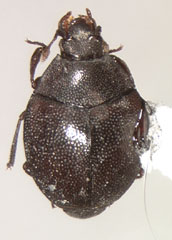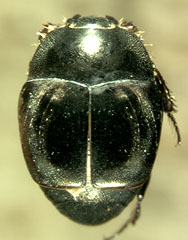Histeroidea
Michael S. Caterino


This tree diagram shows the relationships between several groups of organisms.
The root of the current tree connects the organisms featured in this tree to their containing group and the rest of the Tree of Life. The basal branching point in the tree represents the ancestor of the other groups in the tree. This ancestor diversified over time into several descendent subgroups, which are represented as internal nodes and terminal taxa to the right.

You can click on the root to travel down the Tree of Life all the way to the root of all Life, and you can click on the names of descendent subgroups to travel up the Tree of Life all the way to individual species.
For more information on ToL tree formatting, please see Interpreting the Tree or Classification. To learn more about phylogenetic trees, please visit our Phylogenetic Biology pages.
close boxRelationships after Caterino & Vogler 2002.
Unless otherwise stated, the generic classifcation used throughout the staphylinoids in the ToL follows Newton and Thayer (2005).
References
Archangelsky, M. 1998. Phylogeny of Hydrophiloidea using characters from adult and preimaginal stages. Systematic Entomology 23: 9-24.
Caterino, M. S., and A. P. Vogler. 2002. The phylogeny of the Histeroidea. Cladistics 18(4):394-415.
Beutel, R. G. 1994. Phylogenetic analysis of Hydrophiloidea based on characters of the head of adults and larvae. Koleopterologische Rundschau 64: 103-131.
Beutel, R. G. 1999. Morphology and evolution of the larval head of Hydrophiloidea and Histeroidea. Tijdschrift voor Entomologie 142: 9-30.
Hansen, M. 1991. The hydrophiloid beetles. Phylogeny, classification and a revision of the genera. Biologiske Skrifter 40: 1-368.
Hansen, M. 1995. Evolution and classification of the Hydrophiloidea - A systematic review. Pages 321-353 in Biology, Phylogeny, and Classification of the Coleoptera: Papers Celebrating the 80th Birthday of Roy A. Crowson (J. Pakaluk, and S. A. Slipinski, eds.). Muzeum i Instytut Zoologii PAN, Warsaw.Hansen, M. 1997. Phylogeny and classification of the staphyliniform beetle families. Biologiske Skrifter 48: 1-339.
Lawrence, J. F., and A. F. Newton. 1982. Evolution and classification of beetles. Annual Review of Ecology and Systematics 13:261-290.
Lawrence, J. F. and A. F. Newton. 1995. Families and subfamilies of Coleoptera (with selected genera, notes, references and data on family-group names). In J. Pakaluk and S. A. Slipinsky (eds), Families and subfamilies of Coleoptera (with selected genera, notes, references and data on family-group names). Muzeum i Instytut Zoologii PAN, Warsaw, pp. 779-1006.
Mamayev, B. M. 1974. The immature stages of the beetle Syntelia histeroides Lewis in comparison with certain Histeridae. Entomological Review 53: 98-101.
Newton, A. F., Jr. 1990. Larvae of Staphyliniformia (Coleoptera): where do we stand? Coleopterists Bulletin 44: 205-210.
Newton, A. F. 1991. Agyrtidae-Silphidae (pp. 324-341); Pselaphidae (pp. 353-355); Sphaeritidae-Histeridae (pp. 341-352). In F. W. Stehr (ed) Agyrtidae-Silphidae (pp. 324-341); Pselaphidae (pp. 353-355); Sphaeritidae-Histeridae (pp. 341-352). Kendall/Hunt, Dubuque.
Newton, A. F. 2001. Sphaeritidae. In R. H. Arnett and M. C. Thomas (eds), American Beetles. CRC Press, Boca Raton.
Newton, A. F., Jr. & M. K. Thayer. 1992. Current classification and family-group names in Staphyliniformia (Coleoptera). Fieldiana: Zoology (N. S.) 67: 1-92.
Newton, A. F. & M. K. Thayer. 2005 Catalog of higher taxa, genera, and subgenera of Staphyliniformia. Chicago: Field Museum of Natural History. URL: http://www.fieldmuseum.org/peet_staph/db_1a.html
Nikitsky, N. B. 1976b. On the morphology of a larva Sphaerites glabratus and the phylogeny of Histeroidea. Zoologicheskii Zhurnal 55: 531-537.
Ohara, M. 1994. A revision of the superfamily Histeroidea of Japan. Insecta Mastumurana (N.S.) 51: 1-283.
Slipinski, S. A., and S. Mazur. 1999. Epuraeosoma, a new genus of Histerinae and phylogeny of the family Histeridae. Annales Zoologici (Warszawa) 49:209-230.
Title Illustrations

| Scientific Name | Anapleus cyclonotus |
|---|---|
| Location | India |
| Specimen Condition | Dead Specimen |
| Image Use |
 This media file is licensed under the Creative Commons Attribution-ShareAlike License - Version 3.0. This media file is licensed under the Creative Commons Attribution-ShareAlike License - Version 3.0.
|
| Copyright |
© 2002

|
| Scientific Name | Saprinus discoidalis |
|---|---|
| Location | California |
| Specimen Condition | Dead Specimen |
| Image Use |
 This media file is licensed under the Creative Commons Attribution-ShareAlike License - Version 3.0. This media file is licensed under the Creative Commons Attribution-ShareAlike License - Version 3.0.
|
| Copyright |
© 2002

|
About This Page

Santa Barbara Museum of Natural History, Santa Barbara, California, USA
Correspondence regarding this page should be directed to Michael S. Caterino at
Page copyright © 2007
All Rights Reserved.
- First online 07 March 2002
- Content changed 29 June 2007
Citing this page:
Caterino, Michael S. 2007. Histeroidea. Version 29 June 2007 (under construction). http://tolweb.org/Histeroidea/9075/2007.06.29 in The Tree of Life Web Project, http://tolweb.org/









 Go to quick links
Go to quick search
Go to navigation for this section of the ToL site
Go to detailed links for the ToL site
Go to quick links
Go to quick search
Go to navigation for this section of the ToL site
Go to detailed links for the ToL site